|
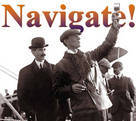
 Up
Up 
 Gustave
Gustave
Whitehead

(You are here.)
 Down
Down




  Need
to Need
to
find your
bearings?
Try
these
navigation aids:
If
this is your first
visit, please stop by:
Something
to share?
Please:



|
|
Available in Française, Español, Português, Deutsch, Россию,
中文,
日本, and others.
 f all the
people who claim to have flown before the Wright brothers, perhaps the
most controversial is Gustave Whitehead. The controversy first arose in
1935 with the publication of a magazine article on Whitehead's
aeronautical ambitions, and it continues to flare from time to time. According to believers in the
Whitehead legend, the first powered flight occurred on August 14, 1901. f all the
people who claim to have flown before the Wright brothers, perhaps the
most controversial is Gustave Whitehead. The controversy first arose in
1935 with the publication of a magazine article on Whitehead's
aeronautical ambitions, and it continues to flare from time to time. According to believers in the
Whitehead legend, the first powered flight occurred on August 14, 1901.
The Legend Begins
Whitehead, or Weisskopf in his native language, was a German immigrant
with an undeniable passion for aviation. He was reasonably skilled with
his hands and worked manual jobs in Boston, New York, Buffalo, Tonawanda,
Johnstown, Pittsburgh, and finally Bridgeport, Connecticut. While in
Boston in 1897 he built a glider for the Boston Aeronautical Society. The
glider did not fly, whether because of Whitehead’s workmanship or the
Society’s direction, it's hard to say. He continued building and
experimenting with airplanes, and his supporters claim that he made
powered flights in both Pittsburgh in 1899 and Bridgeport in 1901 and
early 1902. His letters to periodicals and interviews in newspapers claim
powered flights as early as 1898 and as late as 1903. He was, in fact, one
of several turn-of-the-century experimenters who regularly issued press
releases that described successful flights with no real evidence to back
his claims. Whitehead made his last airplane in 1908 — which did not fly
— then went on to build helicopters which did not fly. The memory of Gustave Whitehead's aeronautical experiments faded as powered flight
became a reality. They were briefly resurrected in 1913 during the
"Patent Wars" between the Wright brothers and Glenn Curtiss.
Curtiss' lawyers raised the possibility that Whitehead and
others may have preceded the Wrights in powered flight. Both the US
District Court for Western New York and the United States Court of
Appeals, Second Circuit,
where the case was adjudicated, examined the evidence and found it
wanting. So instead, Curtiss set
about rebuilding Samuel Langley's Great Aerodrome that had crashed
into the Potomac in 1903 to prove that it could have flown before the
Wrights.
And there the matter rested until January 1935, when the magazine Popular
Aviation published an article about Whitehead -
"Did Whitehead Precede Wright In World's First Powered Flight?"
by Stella Randolph and Harvey Phillips. The parts of this long article
that made the readers sit up and take notice were the accounts of three
powered flights, all alleged to have taken place before the Wright brother’s
first powered flight on December 17, 1903.
1899 — "...in the Oakland suburb of Pittsburgh in the
Spring of 1899, [a]…steam-driven model had carried him and his
assistant a distance of almost a mile. Firemen…lent
their assistance that time to start the machine, while the assistant fed
charcoal to the flame which heated water in the ordinary kitchen boiler
which they were using. …[A]s they went onward and upward, steered by
Gustave Whitehead at the controls in the front, they exceeded the
distance originally planned and found themselves headed for a
three-story brick house. Afraid to attempt to swerve, there was but one
hope, namely that they might clear the top of the house. But they
failed. Down fell the machine, all but demolished, while the agonized
fireman in the back writhed with the pain of a scalded leg."
1901 — "The mile and a half flight, made August 14, 1901,
occurred at Lordship Manor, now a suburb of Bridgeport...One day, [the
No. 21 airplane] was pushed into the street from the backyard of the
modest house, 241 Pine Street, which was then the Whitehead home…Inside
it, two engines were humming, one for propelling the wheels on which it
was to get its start upon the ground, the other to turn the propellers
when the machine was in the air. The small boys of the neighborhood came
running, attracted by the unusual….They drew excited breaths of awe,
and whistled through their teeth as the creature dashed down the road,
rose from the ground, not many feet higher than their heads, and flew
above the dirt road that was then Pine Street."
1902 "On the afternoon of January 17, 1902, the weather
looked promising. It was the day [Whitehead] and his helpers had been
seeking, so they quietly took their new avion, No. 22, to the beach
outside Bridgeport and started its kerosene motor. Gustave Whitehead
took his place at the controls of the machine, the men gave it a
preliminary push, and it trundled away on its three wheels and was off!
The plane performed so admirably that its owner continued his flight for
a distance of two miles over the Sound, following the shore line of the
beach…The men pulled it ashore, and now Gustave Whitehead proposed to
fly across the Sound…He took off again …[and] was steadily
progressing out across the Sound…when it occurred to him that it might
be interesting to see if he could make his machine turn…He turned the
rudder slowly and drove one propeller faster than the other…Steadily
and rapidly the machine came about until he was facing his starting
point. As he neared his rejoicing helpers on the shore, he slowed the
speed of the plane and again dropped it gently into the water. It had
traveled a distance of approximately seven miles, not across the Sound,
but it had made the first turn in the air so far as has been
recorded."
Note: If you'd like to read Randolf and Phillips Popular
Aviation article in its entirety, click
HERE.
Parts of Randolph and Phillip's tale were obvious fabrications. The
account of the 1899 flight in a steam-powered airplane, with a fireman
stoking the fire under the boiler, paints a wonderful picture in the best
tradition of the American tall tale. The story of the 1902 flights is just
as hard to swallow when you read the American Inventor article
that is its one and only source. Whitehead offers no pictures of this
mostly-metal aircraft and the editor describes himself as "hardly
able to credit the account...that a man has actually succeeded in
flying." So Whitehead promises photos will come but never sends them. If
you further read the newspaper interviews with and stories about
Whitehead from the same time period, it becomes clear that the
No. 22 never existed.
Note: If you'd like to read the 1 April 1902 letter from
Gustave Whitehead to the editor of the American Inventor,
click HERE.
The only remotely plausible account of a powered flight in a
Whitehead airplane is the story of the No. 21 in 1901. But
this too unravels when you begin to poke around.
Considering the Sources
Much of that article was inspired by a story titled "Flying" that appeared in the Bridgeport
Herald on 18 August 1901. The Herald was published every
Sunday and featured local Connecticut news. This particular edition reported a flight that Whitehead
claimed to have made four days earlier. This story had fairly wide
coverage - it went out over the wire and within a few weeks
was repeated in over eighty papers, among them the Boston
Transcript and the New York Herald. However, it's telling that
not one of the four daily newspapers in Bridgeport mentioned the
flight. The story didn't even make the front page of the Bridgeport
Herald itself – it was buried five pages back in a
section where editor Richard Howell regularly published human interest
stories and other "soft" news.
"Flying" is difficult to believe in places, much more
than Randolph and Phillip’s retelling. For example, the
reporter claims that before Whitehead flew, he sent the No. 21
aloft with 220 pounds of sand in place of the pilot. The machine landed
safely, the sand was unharmed, so Whitehead took the controls. Owing to
fantastic details like these, the story lacked what advertisers have come
to call verisimilitude – the appearance
of truth. So despite wide coverage and implications that mankind had
successfully flown, the public yawned. After all, this was an old game in
late Victorian America. Whitehead used these newspaper stories to announce
that he was taking on a partner – a mysterious
Texan named W. D. Custead – and the two were
beating the bushes for additional funding, even though Custead claimed to
represent a "company of Southern gentlemen with unlimited
capital." The multiple newspaper accounts had all the hallmarks of
yet another public relations campaign designed to attract investors.
Note: If you'd like to read the Bridgeport Herald article
"Flying"
in its entirety, click
HERE.
Other sources, many of them letters and statements from Whitehead
himself, contradict the Bridgeport Herald. In the June 1901 issue
of Scientific American, Whitehead tells the readers that the No. 21
can make a turn in the air by varying the speed of the propellers. He has
an engine which pumps gas under high pressure to pistons driving the
propellers, and he can vary the pressure of the gas to each prop. The
18 August 1901 edition of the Bridgeport Herald tells us a little
more about this engine - it is fueled by
"rapid gas explosions" from acetylene generated from calcium
carbide. Yet in that same article Gustave Whitehead gives a firsthand
account of a turn he made in the air to avoid a clump of trees and
asserts, "I had no means of steering (italics ours) by using
the machinery." This just two months after telling the Scientific
American audience he could turn by varying the speed of the props! So
he claims to shift his weight, the airplane banked into a turn and he avoided
disaster.
Months later in his letter to The American Inventor,
Whitehead claimed to be flying the No. 22 over Long
Island Sound on 17 January 1902. As he was cruising along, he remembered that he could vary the speed of the props to
make a turn. However, according to
that same letter, he was using an internal combustion kerosene engine to run them. He
had apparently discarded the acetylene engine, and with it went the
alleged means for varying gas pressure and prop speed.
We asked Andy Kosch, who built and flew a replica of the No. 21 in 1986
and 1987 about these discrepancies. Andy maintained that Whitehead had
some sort of "transmission" in the No. 22 to vary the prop
speed, although Whitehead did not mention it in his letters to
publications. Andy also told us that he doubted that the quotes ascribed
to Whitehead in the Bridgeport Herald article were really his own
words. "A German immigrant wouldn’t talk like that," Andy
observed. This begs a bigger question – if the
reporter was putting words in Whitehead’s mouth, what else was he making
up?
Other details in these sources run the gamut from puzzling to
incredulous. In November, the Bridgeport Herald and the New York
World reported the incredulous: Whitehead was within spitting distance
from having an aircraft factory up and running. He would be selling six
passenger airplanes for $2000 apiece, according to an interview. As
for puzzling, the letters Whitehead sent to Scientific American and
The American Inventor reveal that the horsepower-to-weight
ratio of Whitehead’s engines declined with each new model. According to
his own telling, the efficiency of the acetylene engine driving the
propellers in the No. 21 was 1.75 pounds per horsepower. Four months
later in the No. 22, Whitehead uses a kerosene engine with an efficiency
of approximately 3 pounds per horsepower, a drop of over 70 per cent.
In all fairness, there is some evidence that Whitehead had some skill
as an engine maker in later years. Charles Whittaman, an airplane builder
on Long Island, bought two engines from him in 1908 and 1910 and was
well-satisfied – enough to call him a
"very able designer." But in the years in question -
1899 to 1902 - his words and actions are
impossible to reconcile. He tells us he is getting wonderful results from
each new airplane and engine; then he discards them, never flying them
again.
Aeronautical engineering, like all scientific disciplines, depends on reproducible
results for true advancement. One of the most incredulous parts of the
Whitehead legend is that he never seems to have any. In her article,
Stella Randolf reports that Whitehead made 56 airplanes in a career that
spanned a dozen years – 4.6 aircraft per year, which is in itself
an unbelievable claim – and several of these flew, among them the
No. 21. (It was actually his forty-something aircraft; he hadn't
bothered to number the early ones.) Yet rather than make test
flights and investigate the envelope of what he claims is a capable flying
machine, his No. 21, Whitehead immediately goes on to a six-passenger version
(No. 21-1/2?) and then the imaginary No. 22. He claims to
fly No. 22 only twice and goes on to fly gliders in 1904 and perhaps afterwards. In
1906 and 1908, we have documented failures of two powered airplanes, the
last of which he built for Stanley Beach, son of the editor of Scientific
American. Why couldn’t Gustave Whitehead reproduce the results he
claimed earlier? The Legend Reborn
Despite its implausible claims, discrepancies and contradictory sources, the Popular
Aviation magazine article lit a fire under a few interested scholars.
The Harvard University Committee on Research in the Social Sciences sent
John Crane, a professor of economics to Connecticut. (At the time, Crane
was working on a book on the history of aviation.) He began to interview
the residents of Bridgeport to find out more details about Whitehead's
1901 and 1902 flights. To his surprise, he found only one person who could
remember Whitehead's flights, despite the mention of
"affidavits" in Randolph and Phillips' article. He interviewed
several people who had business dealings with Whitehead, among them John
J. Dvorak, a businessman who spent time in Bridgeport waiting for
Whitehead to produce an engine. Dvorak told Crane that during the six
months he spent in Whitehead’s home town in 1904 -
before Whitehead was making glider flights - he
never met a single person who could remember seeing Whitehead fly. Crane
published the results of his investigation in an objective and
dispassionate article in the
National Aeronautical Association Magazine in December 1936. It was
called "Did Whitehead Actually Fly?" In it he concedes the
possibility that Whitehead made short, unsustained hop-flights
("momentum flights"), but found it highly unlikely he actually flew –
that is, made controlled and sustained powered flights.
Note: If you'd like to read John Crane's report
in its entirety, click
HERE.
This state of amnesia didn't last very long, however. In 1940, Charles
Whitehead was introduced on the radio show Famous Firsts as
"the son of Gustave Whitehead, the first man to fly in a
heavier-than-air machine." The Whitehead story as heard on the radio
was retold in Liberty magazine in April 1945, and the Liberty
article was condensed in Reader's Digest in July 1945. It ran under
the heading of "First" by Mort Weisenger.
"In 1940, (Joseph Nathan) Kane went on the air with Famous
Firsts, parading such milestone-makers as Clarence Birdseye, perfecter
of the frozen-food process; Anna Jarvis, founder of Mother's Day; and
the late Colonel Jacob Ruppert, whose Yankee team was the first modern
ball club to cop three pennants in a row.
"It was during one of these programs that Kane presented Charles
Whitehead of Bridgeport, Conn., as "the son of Gustave Whitehead,
the first man to fly a heavier-than-air machine – two years, four
months and three days previous to the Wright flight at Kitty Hawk.
" This was such a sensational claim that it cost Kane several
hundred dollars to convince skeptics. At his own expense he mailed out
thousands of photostatted newspaper clippings describing in detail a
half-mile motor-controlled flight made by Gustave Whitehead, a Bavarian,
on August 14, 1901. These were supplemented with copies of 11 affidavits
signed by eyewitnesses…"
Orville Wright was still living at this time. He was aware of the
Whitehead story, but did not think anyone took it seriously until it made
its way into Reader's Digest. The 1945 story prompted him to write
a short rebuttal, "The Mythical Whitehead Flight," in the U.S.
Air Services Magazine in August 1945.
"The myth of Gustave Whitehead having made a power flight in
1901 was founded upon the story which appeared in the Bridgeport Herald
of August 18, 1901…The Herald represented that just four persons were
present on the occasion – Gustave Whitehead, Andrew Cellie and James
Dickie, his two partners in the flying machine, and a representative of
the Herald. In an affidavit dated April 2, 1937, the above-mentioned
James Dickie, after saying that he had worked with Gustave Whitehead
when Whitehead was constructing and experimenting with aeroplanes, said:
‘I do not know Andrew Cellie, the other man who is supposed to have
witnessed the flight of August 14th, 1901, described in the Bridgeport
Herald. I believe the entire story in the Herald was imaginary, and grew
out of the comments of Whitehead in discussing what he hoped to get from
his plane. I was not present and did not witness any airplane flight on
August 14, 1901. I do not remember or recall ever hearing of a flight
with this particular plane or any other that Whitehead ever built.’"
"…In May, 1901, Stanley Y. Beach visited Whitehead at
Bridgeport and wrote an illustrated article about Whitehead's machine,
which was published in the Scientific American of June 8, 1901. Later he
induced his father to advance money to continue Whitehead's experiments.
Although Beach saw Whitehead frequently in the years from 1901 to 1910,
Whitehead never told him that he had flown. Beach has said that he does
not believe that any of Whitehead's machines ever left the ground under
their own power, in spite of assertions of persons thirty-five years
later who thought they remembered seeing them. Beach's nine years
association with Whitehead placed him in a better position to know what
Whitehead had done than that of other persons who were associated with
Whitehead but a short time, or those who had so little technical
training, or so little interest that they remained silent for
thirty-five years about an event which, if true, would have been the
greatest historic achievement in aviation up to that time. If Whitehead
really had flown, certainly Beach, who had spent nearly ten thousand
dollars on the experiments, would have been the last to deny it."
|
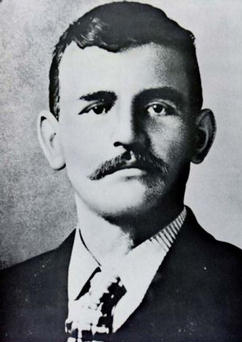
Gustave Whitehead, born 1874, died 1927.

A steam engine built by Whitehead. This was similar to the steam
engines used by Locomobile, a Bridgeport automobile manufacturer
where he had worked.
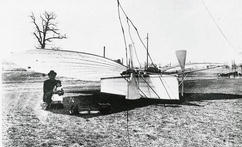
Whitehead seated with his daughter Rose beside the "No.21," built in 1901. He claimed to
have made short flights in this aircraft. Whitehead airplane No.22, which is alleged
to have made longer flights, was similar but the frame was supposedly made
of aluminum tubing rather than bamboo.
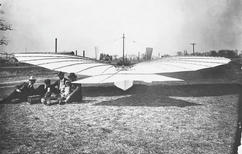
A rear view of Whitehead's No.21. This photo was taken near
Whitehead's shop at 241 Pine Street. The folks beneath the left wing
are (from left to right) Stanley Y. Beach (who wrote an article on
the aircraft for Scientific
American), Andrew Cellie, Daniel Varoni, and Gustave
Whitehead with his daughter Rose on his lap.
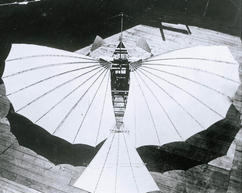
And a view from above. The wings are very similar to those of
Otto Lilienthal's gliders.
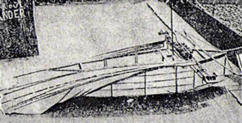
The Whitehead No. 21 with the wings folded. Lilienthal gliders also
had foldable wings.
View Whitehead's Shop in a larger map.
The former location of Whitehead's shop in
Bridgeport, CT and the location where the August 14, 1901 flight
allegedly took place. If you use
Google Earth and you'd like
to explore this neighborhood online,
click HERE.
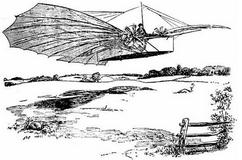
The story in the
Bridgeport Herald was accompanied by this sketch of the No.
21 in flight by staff artist "Dad" Barber. Whitehead
advocates suggest the art was based on an actual photograph, which
is an impossibility. The alleged flight was made during the night of
a new moon, so there not enough light available for photography.
There was no "low-light" film in 1901; the ASA of available films
were in the single digits.
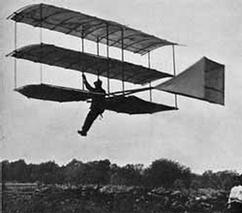
Whitehead built this triplane glider in 1903 and allegedly flew it until 1904.
Although this photo seems to show the glider was flightworthy,
uncropped versions of the photo show it suspended on wires for the
shot. There are, however, other shots of this glider showing it
being towed aloft.
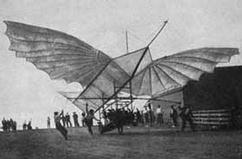
In 1904, Whitehead built and flew a second glider, this with
Lilienthal-style wings.
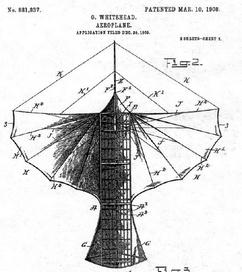
Whitehead's patent for his 1904 glider, granted in 1908.
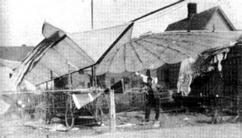
In 1905, Whitehead added an engine and propeller to his 1904 glider.
He attempted to fly it in 1906 but was unsuccessful. He called it the "Albatross."
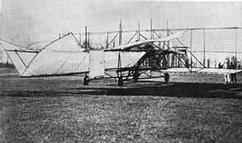
Whitehead built this odd aircraft for Stanley Y. Beach in
1908. It actually had two sets of wings – flat, camber-less biplane
wings forward of the fuselage and Lilienthal-like monoplane wings
just behind them. It never flew under its own power, but it was towed aloft
behind Beach's automobile.
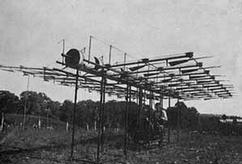
Whitehead's last known aeronautical project was this helicopter with
over 60 small rotors. The engine was not powerful enough to drive
the rotors at the speed required for lift off.
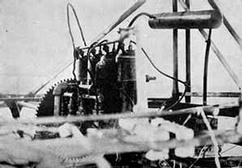
A Whitehead 4-cylinder engine with a small gravity-fed fuel tank installed
in an airplane, possibly the airplane he built for Stanley Beach in 1908. It is occasionally
mistaken as the engine in the No.21.
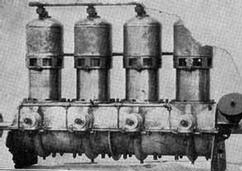
Another view of Whitehead's 1908 engine.
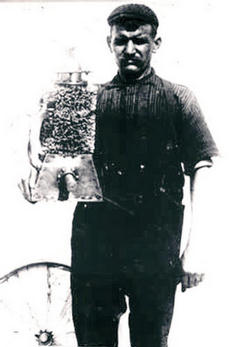
Gustave Whitehead with a lightweight
two-cylinder engine. He manufactured about 30 engines altogether.
|
|
|
|
The Story Behind the Legend
What Orville didn't say in that rebuttal was that he suspected that the
Whitehead story was being manipulated by an old nemesis,
Albert Zahm. Zahm
was a consultant at the Smithsonian Aerodynamical Laboratory
(the forerunner of NACA, later NASA) when the Wrights launched their
patent suit against Glenn Curtiss in 1909. Zahm had been an expert witness
for Curtiss and also wrote a report on the performance of
Langley's 1903
Aerodrome A when Curtiss modified it and made several hop-flights in 1914. This was done to establish the possibility that another aircraft may have been capable of flight before the
Wright Flyer, a point that Curtiss wished to make in the courts to help
his patent suit. Zahm's report, which glossed over the modifications Curtiss
had made to the Aerodrome to make it airworthy, was published by
the Smithsonian in 1915. This incurred Orville's
wrath and began an arm-wrestling match between Orville Wright and the
Smithsonian Institution that Orville eventually won in the court of public
opinion. In 1943, the Smithsonian recanted its position that the Langley
Aerodrome was capable of flight in its 1903 configuration and admitted
that Zahm's report was flawed. Zahm, however, remained steadfast.
He issued his own rebuttal to Orville's U.S.
Air Services Magazine article, entitled
"Whitehead First To Fly With Petrol Power" and even offered a
reward for a photo of any Whitehead airplane in flight.
In his book Wilbur and Orville, author Fred Howard explains the
involvement of Albert Zahm in the Whitehead story thus:
The campaign to discredit the brothers had not ended with the
termination of the suit against Curtiss in 1917. The anti-Wright
propaganda had never ceased to proliferate, and its source in Orville's
opinion was Albert Zahm. Zahm had left the Smithsonian's Aerodynamical
Laboratory in 1915 to become chief research engineer of the Curtiss
Aeroplane Company. Two years later he left Curtiss to become director of
the U.S. Navy Aerodynamics Laboratory. In 1925 he was awarded the
Laetare Medal by his alma mater, Notre Dame University, as the
outstanding Catholic layman of the year for his work as scientist and
pioneer in the field of aerial navigation. When the Guggenheim Chair of
Aeronautics was established in the Library of Congress in 1929, Albert
Zahm became the chair's first incumbent. Since his primary task as chief
of the library's Aeronautics Division was to acquire aeronautical
material for the library's collections, he was in an ideal position to
carry out his campaign of belittlement. The claim of any person to have
flown before the Wright brothers was carefully considered. Zahm's most
successful effort in this line was the creation of a revival of interest
in the discredited German-American Gustave Weisskopf – or Whitehead –
who claimed to have made at least two flights before the Wright brothers
first flew in 1903."
Orville was aware of Randolph and Phillip’s article, and was aware
that Randolph expanded the article into a book in 1937, The Lost
Flights of Gustave Whitehead. He had heard from several sources that
Albert Zahm had urged its publication. Stella Randolph, who worked in a
doctor's office and had no expertise in aviation, was persuaded by Harvey
Phillips (who worked under Paul Garber at the Smithsonian) to collaborate on the Popular Aviation article about
Whitehead. Afterwards, Zahm apparently encouraged her to expand the
article into a book. Orville did not comment publicly on either
publication, but privately told friends the book was "too incredible
and ridiculous to require serious refutation."
Orville, however, may have been mistaken in thinking that Zahm and
Randolph were in cahoots. In later years, Randolph often remarked that she
did not get along with Zahm and felt he was trying to use her, even steal
her research. His rabid anti-Wright attitude put her off and she did
everything she could to distance herself from him.
It’s also apparent that Zahm had his own agenda, independent of
Randolph. He had been publishing his version of aviation history for many
years before he and Randolph crossed paths, beginning with his book Aerial
Navigation in 1911. This publication downplayed the role of the
Wrights in pioneer aviation, painting the invention of the airplane as the
slow accumulation of data and experience by many different experimenters.
He took one last swing at the Wright brothers in 1945 with a forty-page
booklet, Early Powerplane Fathers. In it, Gustave Whitehead was the
most successful of Zahm's four candidates for the true inventors of the
airplane, all of which preceded the Wrights.
Albert Zahm retired from the Library of Congress in the same year he
published Early Powerplane Fathers. He was probably
gratified with the resurgence of public interest in Gustave Whitehead,
although that was due more to Kane’s radio broadcast and the Reader’s
Digest article than it was to his or even Stella Randolph’s efforts.
That interest ratcheted up a notch in 1964, when Air Force Reserve Major
William O' Dwyer produced some hitherto unknown photos of Whitehead’s
airplanes and joined forces with Randolph to have Whitehead declared the
"father of Connecticut aviation." That precipitated another book
(History by Contract) and a few television documentaries, complete
with a newly exposed "conspiracy" to keep Whitehead from
receiving the recognition due him. Randolph and O’Dwyer claimed to have
discovered a
clandestine agreement between the Wright estate and the
Smithsonian Institution that the 1903 Wright Flyer would be returned
if the Smithsonian ever recognized anyone other than the Wrights to be
the first people to make a "controlled, sustained, powered flight." The
so-called "secret" agreement was public record and had been
mentioned – even explained in detail –
by several Wright biographers. Ironically, Orville's heirs had put this
agreement in place to protect the Wright brothers from Albert Zahm –
and any future Albert Zahms that the Smithsonian might someday put in a
position of authority. Sustaining the Legend
Today, the Whitehead legend needs no help from a Randolph or a Zahm to
sustain itself. There are groups of zealous supporters in America and
Germany to keep the flame burning. These organizations get periodic shots
in the arm from the media which knows – like
the late Victorian magazines and newspapers before them –
that the Whitehead story draws an audience, regardless of its scientific
or historic merits.
When called upon by the media, the supporters of Whitehead rely on
three major themes to argue his case.
- Whitehead never flew his aircraft more than once or twice because he
was a perfectionist.
- Affidavits and other reports from eyewitnesses prove
Whitehead flew.
- Recently-developed replicas of Whitehead’s airplanes
prove the originals were airworthy.
Perfectionist – Whitehead
supporters explain that the reason he never reproduced his flights, and
hence was lost to history, was that he was never satisfied with them. This
idea runs through the advocacy of Whitehead beginning with Randolph’s
work in the 1930s. In her book, The Lost Flights of Gustave Whitehead, she
writes:
"The flights of Gustave Whitehead were lost from the pages of
aviation history for two reasons: They were premature –
the public was not willing to believe such nonsense as a man flying –
and Whitehead was dissatisfied with his own success.
"In attempts to fly Whitehead was a perfectionist. He had
studied the birds too much to be satisfied with anything less than bird
performance."
Contrast this view of a perfectionist with the reports in the
newspapers in 1901, just after his alleged August flight. A November New
York World article titled "Flying Machines Soon at $2,000
Each," quotes Whitehead as saying, "A flying machine will be out
on the market that will accommodate six persons, the cost will be about
$2,000." Remember that Whitehead had only recently discovered he
needed a steering system for his airplanes and he was still two months
away from actually testing it, by his own telling. Yet here he is
announcing the impending availability of airplanes that will carry
passengers. Their very lives will depend on his untested steering system.
Perfectionists don’t usually overlook these sorts of details.
Affidavits - Another drum that
Whitehead's supporters beat is that there are just too many people who
remember seeing Whitehead fly for there not to have been some flying going
on. There are several affidavits that Stella Randolph collected from
people in the 1930s who say they saw Whitehead fly some 35 years
previously. And these stories persist, even today. "Bridgeport people
stop in all the time and tell me their grandfathers and grandmothers
remembered seeing Whitehead fly," Kosch told us. There is little
doubt that these people are telling the truth. Whitehead did make some
public glider flights after 1904. Stanley Beach once towed the
Whitehead/Beach airplane aloft behind his automobile and people saw it in
tethered flight. But did they see Whitehead fly on August 14, 1901? Or did
they simply misremember flights they had seen later as children? To give
you an idea of just how one’s memory can play tricks, read Stella
Randolph’s own words in the opening to her 1978 book, History by
Contract (co-authored by William O.Dwyer), as she reconstructs a childhood experience:
"My father, always interested in anything progressive, read
about the efforts of the Wrights in a bee-keepers journal, published by
A.I. Root of Dayton, Ohio. (He was actually from Medina, 175 miles
away.) I was a little girl, but
well recall (italics ours) hearing my father exclaim with
delight, "Those boys are going to fly." My childish
imagination pictured them with flapping wings and wondered how it could
be. One year and two weeks before the Wright’s acclaimed success,
December 17, 1903, my father died; he had not the satisfaction of seeing
his prophecy come true."
To those familiar with early aviation history, the error in her
statement is obvious. Amos Root wrote his famous story in late autumn of 1904,
almost two years after Randolph’s father had died. Given that, it is
puzzling that Whitehead supporters insist on relying on testimony taken
decades after alleged flights from people who were children at the time,
just as Randolph was when her father allegedly remarked on a magazine
article that had not yet been written.
|
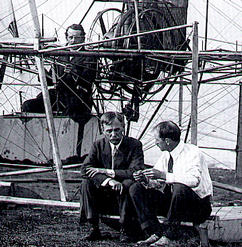
Alfred Zahm (middle) with Glenn Curtiss (right). Charles Manly (left) sits in the cockpit of the dismantled Langley
Aerodrome, which he once tried to fly. The aircraft had been
"reconstructed" for tests that were conducted by the Curtiss
Aeroplane and Motor Company for the Smithsonian Institution. These
tests had two aims – to prove that the Aerodrome could have flown in
1903 and to investigate Langley's distinctive "tandem wing"
configuration.
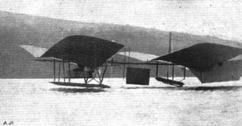
In the first phase of the tests, Curtiss attempted to fly the
Aerodrome with the original Manly-Balzer engine, albeit with a new
ignition system and carburetion. There were also substantial changes
made to the propellers, controls, and airframe. On 28 May, 2 June
and 5 June, Curtiss was able to coax the Aerodrome off the surface
of Lake Keuka near Hammondsport, NY for several hop-flights. None
lasted more than a few seconds or covered more than 200 feet – the
flights could not be sustained. Nonetheless, Curtiss and the
Smithsonian claimed this proved the Aerodrome could have flown in
1903. To read more about these tests and their consequences see
The Wright/Smithsonian Controversy.
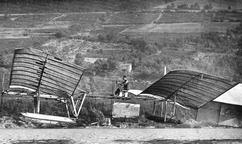
The second phase of the tests lasted from September 1914 to November
1915. Here pilot Elwood "Gink" Doherty makes a sustained
flight in a heavily modified Langley Aerodrome on 17 September 1914
to see what advantages, if any, Langley's unique design might offer
for contemporary aeronautics. To make the old aircraft flyable, the
Curtiss crew added a more powerful engine and a modern propeller.
There were also further airframe changes, including a different rigging system to increase structural
integrity. Coincidentally, these were some of the same modifications made by
builders in the U.S. and Germany to render their No. 21 replicas
airworthy.
|
|
|
|
Replicas - More recently,
supporters of Gustave Whitehead under the direction of Andy Kosch (in the
United States) and the Weisskopf Museum (in Germany) have
attempted to bolster their case by building and flying replicas of
Whitehead’s No. 21, reconstructed from photos and sketches. In
doing so they are essentially conducting experiments in "new
archaeology," a discipline that has developed since the 1970s. A
"new archaeologist" recreates the circumstances of a historic or
prehistoric event as closely as possible and deals with the problems that
crop up using the technology available at the time to better understand
that event and the people who lived through it. Many such experiments are
launched to test an ancient technology and see if it is possible to shape
an arrowhead or raise a pyramid using such-and-such a method. These
experiments do not prove what happened, they simply test the
possibilities – any new archaeologist worth his
flint will tell you the same. By the same token, the flights of Whitehead
replicas do not prove that Whitehead ever flew. They simply indicate the
possibility, despite the assertions from both America and Germany that
their replicas have proved the validity of Whitehead story. Both sets of
experiments are suspect in any event, considering both replicas used
modern ultralight engines and high-speed propellers. They have also
augmented the rigging shown in photos of the original No. 21, bracing
each rib at three points instead of just one. And they have changed the
type and placement of the wheels, using rubber-tired pneumatic wheels
mounted outboard of the fuselage rather than Whitehead's wooden wheels
set in the fuselage floor. These alterations increase the available
power, thrust, and structural integrity of the replicas over the
original. The altered landing gear increases the stability of the
aircraft on take-off and the ease with which it rolls over the ground.
With each new departure from the original, whatever credence these
replicas might have added to the Whitehead story decreases. Parting Thoughts
Over one hundred years later, the Whitehead legend has more vigor than it did
when Whitehead was actually building airplanes. Even his airplanes seem to
be more successful, as the replicas of the No. 21 have shown by flying
more than once or twice. You can probably look forward to continuing claims as reporters look for
offbeat stories with which to fill newspapers, magazines, and blogs. That’s a
good thing – it creates a lively debate and
raises public interest in pioneer aviation. The more astute of the newly
interested will read the primary sources and discover the contradictions
and personal agendas that obscure the history behind the legend. They will
also discover that for all the time and energy this debate sometimes absorbs, it is remarkably unimportant. While Whitehead believers insist
that he was first to fly, no one claims that his work had any effect on
early aviation or the development of aeronautic science. He never
demonstrated his airplanes in public, never sold a working airplane, and
never taught anyone to fly. Even if someone
someday produces a reliable photo of No. 21 in flight in 1901, it will
be nothing more than a footnote, a curious anomaly in the history of
aviation. Stella Randolph’s vindication and Albert Zahm’s revenge, if
it ever arrives, will seem hardly worth the lifetimes they invested.
Regarding Whitehead himself, he deserves to be respected and admired
for the enthusiasm and passion he brought to the quest for flight. His
statements to young children that some day they would see planes crossing
the sky as regularly as birds certainly mark him as a man of vision. He
was an imaginative and innovative thinker whose scientific and mechanical
skills did not parallel his sense of possibility. In the face of these
qualities, however, it’s hard to ignore his penchant for exaggeration,
obfuscation, and oftentimes bizarrely contradictory proclamations.
|
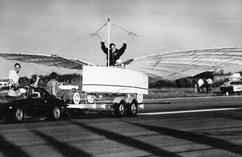
Actor Cliff Robertson, triumphant after being towed aloft in a
Whitehead No. 21 replica. The photo shows that the wing rigging is
attached to three points along the length of each rib, greatly
increasing the structural integrity. (AP Photo by Peter Hvizdak.)
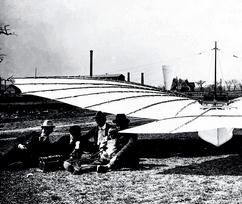
By enhancing this photo to make the wires more easily seen, it's
clear that the rigging wires were attached to a single point on each rib on the original
No. 21. The ribs were made from
bamboo and each was approximately 18 feet long. Rigged in this
manner, it's possible these wings could not have safely supported the
weight of the airplane and its pilot. Furthermore, the aeroelasticity of the inadequately-rigged wings – their tendency to
deform and flutter as the relative wind increased – could have made
the aircraft uncontrollable.
|
|
|
|
Update 2013
On 8 March 2013 Paul Jackson, editor of Jane's All the World's
Aircraft, affirmed the claims of Whitehead's supporters
that he was the first to fly. Jackson cited an analysis of a
photo taken of the
Aero Club of America's Exhibit of Aeronautical
Apparatus in 1906. In that
photo, there are several images hanging on a wall behind a passerby.
None are distinct; blow them up and what you have is a Rorschach
test for aviation historians. Nonetheless, Whitehead supporter Major
William O' Dwyer was the first to suggest that one of
these photos within the photo shows Gustave Whitehead's No. 21 in
flight. Recent supporters have become more specific, asserting that
the photo shows the aircraft 20 feet above the ground at the moment of a catastrophic
failure of the airframe. Despite the convoluted pseudo-science they
went through to "analyze" the blurry shapes,
it was recently
identified as a glider built by
John J. Montgomery, a professor at Santa Clara College in
California.
Even if this had been a Whitehead airplane, it was an odd choice
for proof that Whitehead had preceded the Wright brothers. Whitehead
supporters offered no evidence that the photo within the photo was taken
at any time before 1906; we only knew that it was taken
sometime before the exhibition in which it appears. And if this
photo shows an experimental aircraft coming apart in the air, why was
it offered as proof of a successful flight? More to the point, if
this is a photo of an airplane accident, why wasn't that on
the front page of the Bridgeport Herald in 1901? The
first manned airplane flight is news enough, but the first manned
airplane accident? That is the stuff the sells newspapers!
Perhaps oddest part of this affair is that Whitehead's supporters
chose a photo that was in the possession of William J. Hammer
to make their point. On the wall below the pictures is a sign that
says "Collection of Pictures loaned by W.J. Hammer." To understand
why this is so odd, you need to know Hammer's actions
immediately following the 1906 Aero Club exhibition.
Both Whitehead and the Wright brothers were represented at this
exhibition. There were several photos of Whitehead's No. 21
in the W. J. Hammer Collection, some of which appear on this web page.
The Wright brothers had sent photos and information, along with the
crankshaft and flywheel from their 1903 engine. (These appear in the
photo of the exhibition, just above and to the left of the name of
the photo studio.) During the show, an article
appeared in Scientific American entitled "The Wright
Airplane and its Fabled Performance."
It was critical of the Wrights' claims and all but called them liars.
For whatever reason, William Hammer – a founding member of the Aero
Club of America – thought there might be more to the story. After
the exhibition closed, he took a train to Dayton, Ohio and talked
with the brothers face to face.
Hammer came back certain that the Wright brothers had done what
they claimed to have done. He convinced other members of the Aero Club
of America that the Wrights were the real McCoy and in short order
the Aero Club issued a resolution that said in part:
"Whereas the Messrs. Wright brothers, Wilbur and Orville of
Dayton, Ohio have developed an aeroplane type of flying machine
that many times has carried a man safely through the air at high
speed and continuously over long distances and, therefore, of
practical value to mankind;
"Therefore, be it resolved, that the Aero Club of America
thereby expresses to them the hearty felicitations on their
achievement in devising, constructing and operating a successful
and man-carrying dynamic flying machine..."
When the resolution was released to the press, it also included a letter from the Wright
brothers describing their test flights of 1904 and 1905. This became the
first public announcement that the Wrights had made multiple flights,
navigating complete circles and traveling up to 24 miles. Within weeks, Scientific American
conducted its own investigation and
recanted it's earlier article. The fortunes of the Wrights, who up
to this time had scant luck selling their invention, began
to change.
So here is what's odd: If there was a photo in the exhibition
that showed Whitehead's No. 21 in flight, what
compelled William J. Hammer to go to Dayton? Certainly most of the Aero Club
leadership saw the exhibition, including the Whitehead photos and
the Wright crankshaft. What decided them to issue a resolution
endorsing the Wrights' claims but not Whitehead's? We have to assume
that their information was more current and complete than ours. It
certainly would have been easy to check Whitehead's claims;
after all, Bridgeport was just up the road from New York. Apparently there was a
reason the Wrights deserved this endorsement and Whitehead did not.
To heap oddity upon oddity, 25 years ago (1982) one of Paul
Jackson's predecessors, J.W.R. Taylor – then the editor of Jane's
– endorsed Richard Pearse as having beat the Wright brothers into
the air, according to New Zealand newspapers. Pearse was a New
Zealand rancher and would-be aviator whose claim to be the first to
fly was as sketchy as Whitehead's. Jackson did not explain why
Jane's has withdrawn its support from Pearse in favor of
Whitehead.
In fact, Jackson does not explain anything. Instead, he seems to
be slinking away from the controversy he created. After he posted
his "executive overview" endorsing Whitehead on Jane's web
site and criticism began to rise, he went silent. Jackson's
editorial was available for anyone to read for a few months
– we once had a link to it here
– but it was quietly taken down
or hidden behind a firewall. No explanation was offered.
Although you can no longer access Jackson's executive overview,
you can get the gist by reading the multitude of reactions to it. We suggest you
start with historian Carroll Gray's rebuttal
to Jane's at his
Flying Machines web site. Of all aviation historians, Gray has
by far made the most extensive effort to accumulate and interpret
information on Whitehead. For a balanced view from
someone who is neither a supporter of Whitehead or the Wright
brothers, read Daniel C. Schlenoff's editorial in
Scientific American. If you'd like a review of the
historiographic criteria that must be met for historians to
accede that Whitehead's flight preceded the Wrights, read Mick Oakey's
History or Hogwash?
in the July 2013 edition of The Aviation Historian. As for us, we conclude that this
event simply shows that Paul Jackson is the latest – and probably
not the last – on the long list of publishers to be taken in by the
saga of Gustave Whitehead only to later regret it.
|
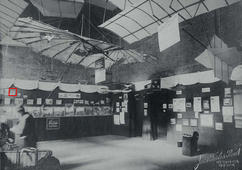
The 1906 Exhibition of Aviation Apparatus. Hanging on the rear wall,
bordered in red, is a photo that some allege to show a Whitehead
aircraft in flight. The photo seems to be part of a collection
belonging to a founding member of the Aero Club, William J. Hammer.
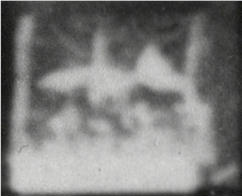
When enlarged approximately 3200% (from 1/4" to 8" tall), the image
from the exhibition photo is a blur with vague shapes and no identifying detail.
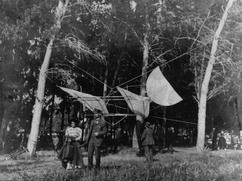
Historians Craig Harwood, who co-authored
Quest for Flight: John J. Montgomery and the Dawn of Aviation in the
West, and Carroll Gray of
flyingmachines.org
surmised the blur might be a Montgomery glider. Harwood dug up this
photo, sent it to Gray, who in turn showed it to us. This is the glider
California displayed in San Jose in 1905.The trees and the
tail seem to match some of the shapes in the blur, but the wings do
not.
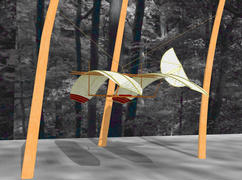
Assuming that the blur might be a photo of the same event taken from
another angle, WBAC director Nick Engler drew the glider with 3D
graphics software and turned it counterclockwise.
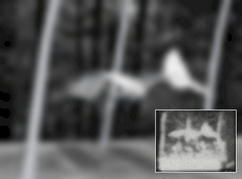
When the resulting illustration is stripped of color, reduced by
3200% and re-enlarged, the results are a reasonable match for the
blurry photo. Read more about our photo analysis
HERE.
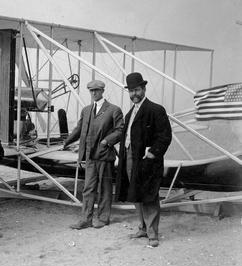
Wilbur Wright (left) with William J. Hammer (right) on Governors
Island during the Hudson-Fulton Celebration in 1909.
|
|
|
|
Post Script: Substitute House Bill 6671 was passed by the Connecticut legislature
and signed into law by Connecticut Governor Daniel P. Malloy on
25 June 2013. The bill seeks to
correct history by recognizing “Powered Flight Day” as a day
honoring Whitehead as the first to take to the air. It also
designates the "Connecticut Waltz" as the state's second official
song and the “Ballroom Polka” as the state’s only official polka. We
suggest
reading
John Steele Gordon's take on the legislation. And here's yet
another oddity: It was U.S. Senator Hiram Bingham of Connecticut
who along with North Carolina congressman Lindsay Warren introduced
legislation in 1926 to establish the Wright brothers' memorial at Kitty
Hawk. Bingham was an accomplished aviator, archaeologist, and
professor of history at both Harvard and Yale.
No word yet on how Connecticut's politicians will deal with the
odd turn of events occasioned by the identification of the blurry
photo-in-a-photo as
something other than a Whitehead airplane and Janes' All the
World's Aircraft seeming to have abandoned their endorsement of
Whitehead. Time for another polka, perhaps.
Other Opinions
-
Gustave Whitehead
-- What Did He Do? — This is probably the most
extensive and certainly the most detailed and well-researched of the web
sites that focus on the accomplishments of Gustave Whitehead. It is
actually a sub-site of a larger site,
flyingmachines.org, which provides excellent information on pioneer
aviators and inventors.
-
Weisskopf Museum, Germany — Available in both English and German,
this web site offers a concise history of Gustave Whitehead as well as photos of a Whitehead
No. 21 replica being towed
aloft.
Our thanks to Louis Chmiel who provided much of the
research for this page.
|
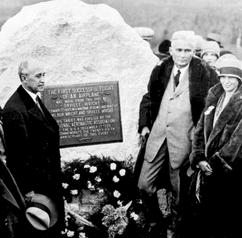
Orville Wright (left) with Connecticut Senator Hiram Bingham
(middle) and Amelia Earhart (right) at the cornerstone ceremony for
the Wright Brothers National Memorial in 1928. The press had dubbed
Bingham "the Flying Senator" for his role in training
American pilots for World War I.
|
|
|
|